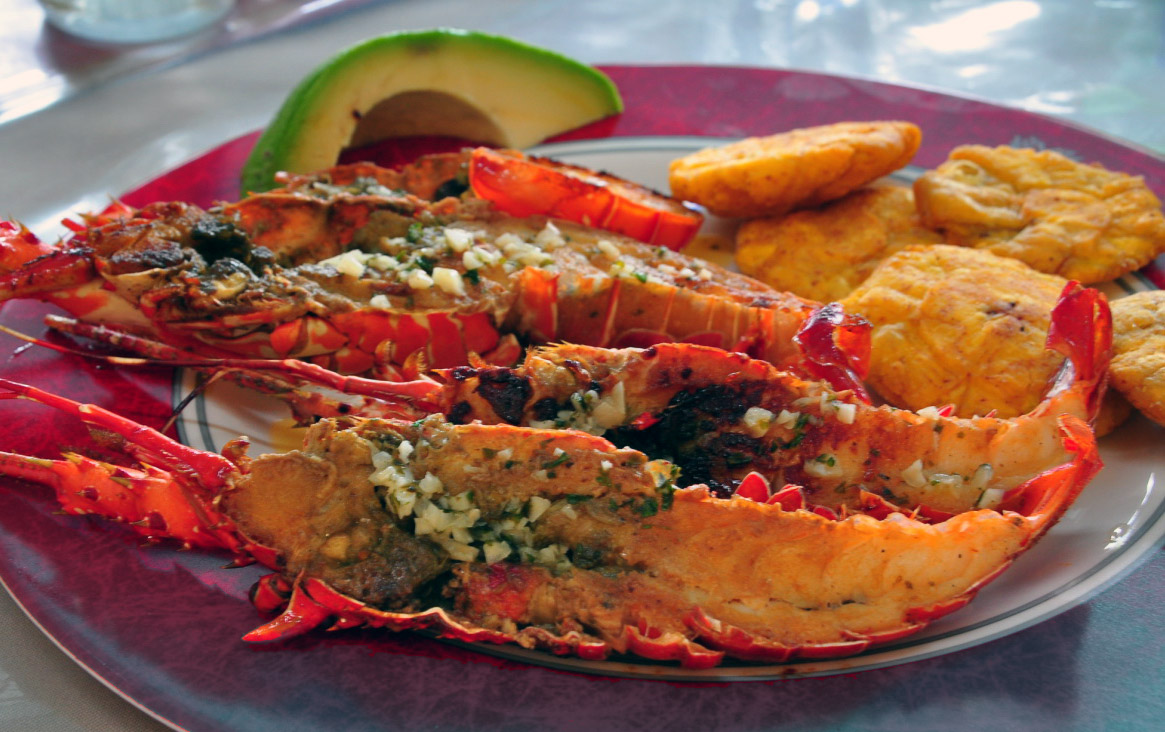
Langosta (lobster or jumbo shrimp) served with patacones (fried mashed plantain). Photo © Rinaldo Wurglitsch, licensed Creative Commons Attribution.
Ecuador isn’t known for gourmet cookery, but perhaps the best food is found on the coast, and many of these specialties are available on the Galápagos. Prices tend to be considerably higher because, aside from freshly caught seafood, most food is flown or shipped in. Look hard enough in the three main ports, however, and you can find two-course set meals for $4-5. If you are on a tight budget, the best way is to seek out favorite local haunts. In Puerto Ayora, the pedestrianized zone along Binford has particularly good value, and many restaurants along Darwin do set meals without advertising, so check out where the locals are eating. Ceviche is one of Ecuador’s most famous dishes and consists of seafood (often raw), onions, and coriander marinated in lemon or lime juice, often served with a dish of popcorn on the side.At breakfast (desayuno), for $3-5 you can get tostada (toast) or fresh pan (bread) with mantequilla (butter) and mermelada (jam), huevos (eggs) served fritos (fried) or revueltos (scrambled), with café (coffee) and jugo (juice) to wash it down. Some places offer healthier options such as a bowl of fruit, yogurt, and granola. Locals often eat bolón, a fried ball of green plantains filled with cheese or bacon.
For lunch and dinner the best food on offer is, of course, seafood. Popular fish include corvina (white sea bass) and dorado. Fish is usually offered frito (fried), apanada (breaded and fried), al vapor (steamed), a la plancha (filleted and baked, literally “on the board”), or al ajillo (in garlic sauce). Camarones (shrimp) are also popular, and other shellfish include cangrejo (crab), calamare (squid), ostione (oysters), and langosta (lobster or jumbo shrimp). Another popular specialty, originating from the north coast, is encocado, seafood cooked with sweet coconut milk. Patacones, small pieces of plantain mashed flat and fried crispy, usually accompany seafood dishes and originally hail from Colombia. Salads accompanying seafood tend to come with a dressing made from lemon juice and salt.
Ceviche is one of Ecuador’s most famous dishes and consists of seafood (often raw), onions, and coriander marinated in lemon or lime juice, often served with a dish of popcorn on the side. When shrimp is used in ceviche, it’s cooked beforehand, but those made with raw pescado (fish) or concha (clams) may pose a health risk. If you prefer your seafood soup hot, try sopa de pescado (fish soup).
Rice and beans are common accompaniments of any meal. Beans are usually cooked in a sauce and served as menestra, which can also be made with lentils. Meats include lomo (beef, also called res or simply carne, “meat”) and chancho (pork), served a la parilla (roasted) or asada (grilled). Chuletas are pork chops, and hamburguesas are burgers. A local meat specialty is a seco, literally a “dry” stew, but in practice it usually has a sauce made of tomatoes, onions, and coriander. Choose beef, pollo (chicken), or chivo (goat). Estofado is another type of stew made with either chicken or meat and usually containing potatoes and carrots. Bistec is a version of beefsteak, usually cooked with tomatoes and onions.
As on the mainland, a vast range of fresh fruit is available, which locals make into jugos (juices) and batidos (milk shakes). They’re often made very sweet, and you can ask for less sugar (menos azucar). A juice is usually included with a set meal. Local beers include Pilsner (small or large bottles), weaker Pilsner Light (small bottles) and stronger Club Verde (small bottles and cans), but beer connoisseurs will be disappointed. Go easy on the alcohol, as sailing and a hangover make a horrendous combination.
On the downside, the cleanliness of the water supply in the ports of the Galápagos is poor. Hygiene in very cheap restaurants can be a problem, and food poisoning does happen, although a mild case of diarrhea is more common. In the good hotels and restaurants, you’re less likely to be sick. The biggest culprits are unpeeled raw fruit and vegetables, salads, ice, pork, and shellfish. Needless to say, always buy bottled water, and never drink from the faucet. If you do get sick, medicine can be obtained easily from a pharmacy in the port, or your guide may have some available.
If Ecuadorian specialties are not for you, Puerto Ayora has a wide range of international cuisine, including Italian, Chinese, and even sushi. There are also a few good international options in Baquerizo Moreno.
Excerpted from the First Edition of Moon Galapagos Islands.